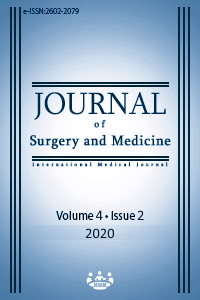Predictive value of plateletcrit in the diagnosis of lower extremity deep vein thrombosis
Keywords:
Venous thrombosis, Platelets, Blood cells, Blood vesselsAbstract
Aim: Deep vein thrombosis (DVT) is a prevalent cause of mortality and morbidity mostly seen in the lower extremities. Early diagnosis is important in terms of the usability of mechanical thrombolysis methods. In this study, we aimed to investigate the diagnostic value of Plateletcrit (PCT) values in patients with suspected DVT.
Methods: Patients who were admitted to our clinic with suspected DVT between January 10, 2017-January 10, 2020 were included in this retrospective cohort study. As a result of their examination with a preliminary diagnosis of DVT, patients who were not diagnosed with DVT were recorded as Group 1, and those with DVT were recorded as Group 2. Univariate and multivariate logistic regression analyses were performed to reveal parameters supporting the diagnosis of DVT.
Results: A total of 139 patients were included in the study. The mean ages of patients in Group 1 (n=33) and Group 2 (n=106) were 45.7 (11.3) years and 53.9 (12.8) years, respectively. Age, body mass index (BMI) and trauma history rates were significantly higher in Group 2 (P values: P=0.019, P=0.038, P=0.015, respectively). The mean platelet volume (MPV), C-reactive protein (CRP), D-Dimer and PCT values were significantly higher in group 2 (P values; P =0.001, P=0.018, P<0.001, P<0.001, respectively). In the ROC analysis, the cut-off value for PCT was 0.1989 (AUC = 0.732, P<0.001, 70.8% sensitivity, 66.7% specificity)
Conclusion: In this study, we found that PCT value, which can be obtained easily and cheaply from routine blood parameters, may be a predictor in patients with suspected DVT.
Downloads
References
Jang MJ, Bang SM, Oh D. Incidence of venous thromboembolism in Korea: From the Health Insurance Review and Assessment Service database. J Thromb Haemost. 2011;9:85–91.
Aydın H, Engin M. Lower limb deep venous thrombosis due to vertebral osteophyte: a May-Thurner-like syndrome. Eur Res J. 2020. DOI: 10.18621/eurj.601306
Akgül E, Engin M, Özyazıcıoğlu AF. Effects of mean platelet volume and platelet counts on peripheral biodegradable stent restenosis. J Surg Med. 2019;3(9):663-5.
Velioğlu Y, Yüksel A. Utility of platelet-to-lymphocyte ratio to support the diagnosis of acute deep vein thrombosis. Turk Gogus Kalp Dama. 2019;27(4):493-8.
Han JS, Park TS, Cho SY, Joh JH, Ahn HJ. Increased mean platelet volume and mean platelet volume/platelet count ratio in Korean patients with deep vein thrombosis. Platelets. 2013; 24(8):590–3.
Citirik M. Central retinal vein occlusion associated with platelet activation. Ther Adv Ophthalmol. 2019;11:1-5.
Shitrit D, Heyd J, Raveh D, Rudensky B. Diagnostic value of the D-dimer test in deep vein thrombosis: improved results by a new assay method and by using discriminate levels. Thromb Res. 2001;102(2):125–31.
Ilkhanipour K, Wolfson AB, Walker H, Cillo J, Rolniak S, Cockly P, et al. Combining clinical risk with D-dimer testing to rule out deep vein thrombosis. J Emerg Med. 2004;27(3):233–9.
Karagoz I, Aktas G, Yoldas H, Yildiz I, Ogun MN, Bilgi M, et al. Association between hemogram parameters and survival of critically Ill patients. J Intensive Care Med. 2019;34:511-3.
Jahangiri Y, Endo M, Al-Hakim R, Kaufman JA, Farsad K. Early Venous Stent Failure Predicted by Platelet Count and Neutrophil/Lymphocyte Ratio. Circ J. 2019;83(2):320-6.
Yüksel M, Yıldız A, Oylumlu M, Akyüz A, Aydın M, Kaya H, et al. The association between platelet/lymphocyte ratio and coronary artery disease severity. Anatol J Cardiol. 2015;15(8):640-7.
Çalışkan A, Yazıcı S, Karahan O, Demirtaş S, Yavuz C, Güçlü O, et al. The investigation of complete blood counting parameters in deep venous thrombosis. Dicle Med J. 2014;41:118-22.
Gulcan M, Varol E, Etli M, Aksoy F, Kayan M. Mean platelet volume is increased in patients with deep vein thrombosis. Clin Appl Thromb Hemost. 2012;18:427-30.
Bath, PM, Butterworth, RJ. Platelet size: measurement, physiology and vascular disease. Blood Coagul Fibrinolysis. 1996;7(2):157–61.
Boos, CJ, Lip, GY. Assessment of mean platelet volume in coronary artery disease—what does it mean? Thromb Res. 2007;120(1):11–3.
Dai Z, Gao J, Li S, Li R, Chen Z, Liang M, et al. Mean Platelet Volume as a Predictor for Restenosis After Carotid Angioplasty and Stenting. Stroke. 2018 Apr;49(4):872-6.
Dündar TT, Kitiş S, Abdallah A, Yurtsever İ, Gülen B. Evaluation of the platelet volume index as a prognostic factor after aneurysmal subarachnoid hemorrhage. J Surg Med. 2019;3(9):685-8.
Cil H, Yavuz C, Islamoglu Y, Tekbas EÖ, Demirtas S, Atilgan ZA, et al. Platelet count and mean platelet volume in patients with in-hospital deep venous thrombosis. Clin Appl Thromb Hemost. 2012;18(6):650-3.
Canan A, Halıcioğlu SS, Gürel S. Mean platelet volume and D-dimer in patients with suspected deep venous thrombosis. J Thromb Thrombolysis. 2012;34(2):283-7.
Akpinar I, Sayin MR, Gursoy YC, Karabag T, Kucuk E, Buyukuysal MC, et al. Plateletcrit. A platelet marker associated with saphenous vein graft disease. Herz. 2014;39(1):142-8.
Aynıoglu O, Isık H, Sahbaz A, Harma MI, Isık M, Kokturk F. Can Plateletcrit be a Marker for Recurrent Pregnancy Loss? Clin Appl Thromb Hemost. 2016;22(5):447-52.
Vázquez-Santiago M, Vilalta N, Ziyatdinov A, Cuevas B, Macho R, Pujol-Moix N, et al. Platelet count and plateletcrit are associated with an increased risk of venous thrombosis in females. Results from the RETROVE study. Thromb Res. 2017;157:162-4.
Bendinelli C, Balogh Z. Postinjury thromboprophylaxis. Curr Opin Crit Care. 2008;14:673–8.
Engin M. May- Thurner ve Nutcracker Sendromu. In: Kahraman N, ed. Venöz ve Lenfatik Sistem Hastalıkları. Ankara: Akademisyen yayınevi; 2020. pp. 179–196.
Downloads
- 600 1172
Published
Issue
Section
How to Cite
License
Copyright (c) 2020 Mustafa Abanoz
This work is licensed under a Creative Commons Attribution-NonCommercial-NoDerivatives 4.0 International License.
















